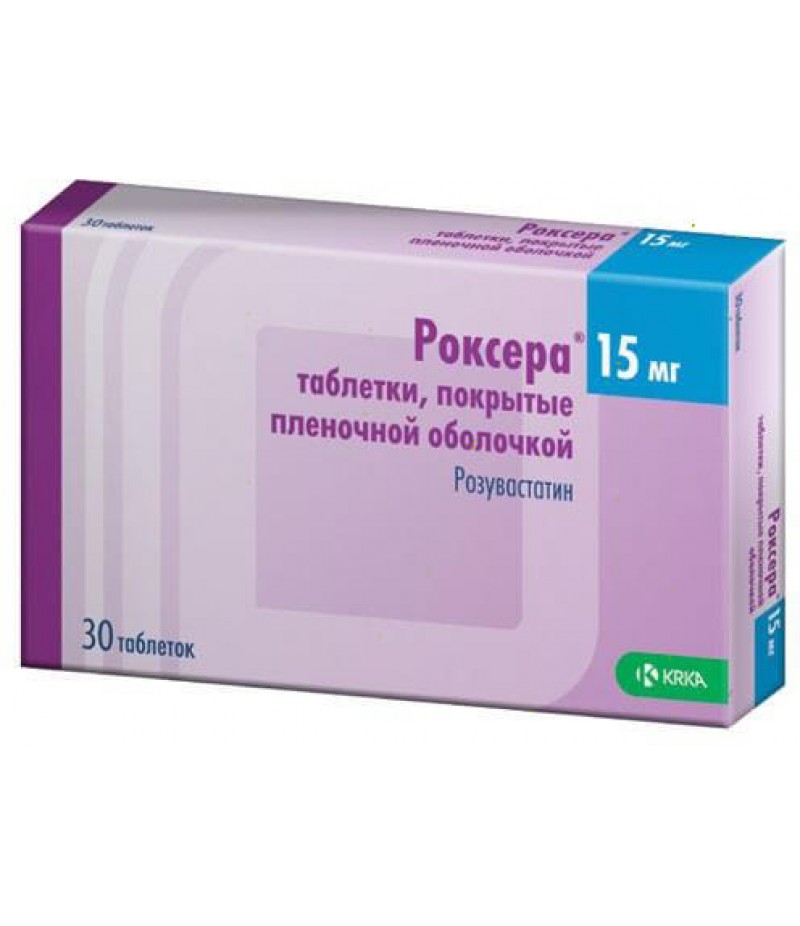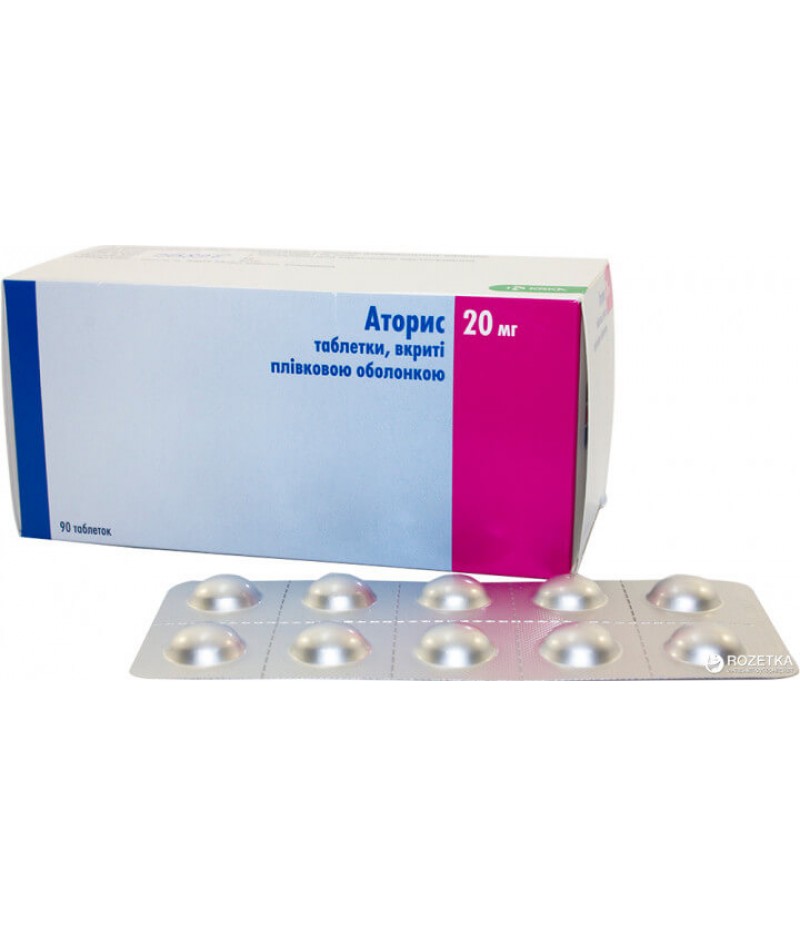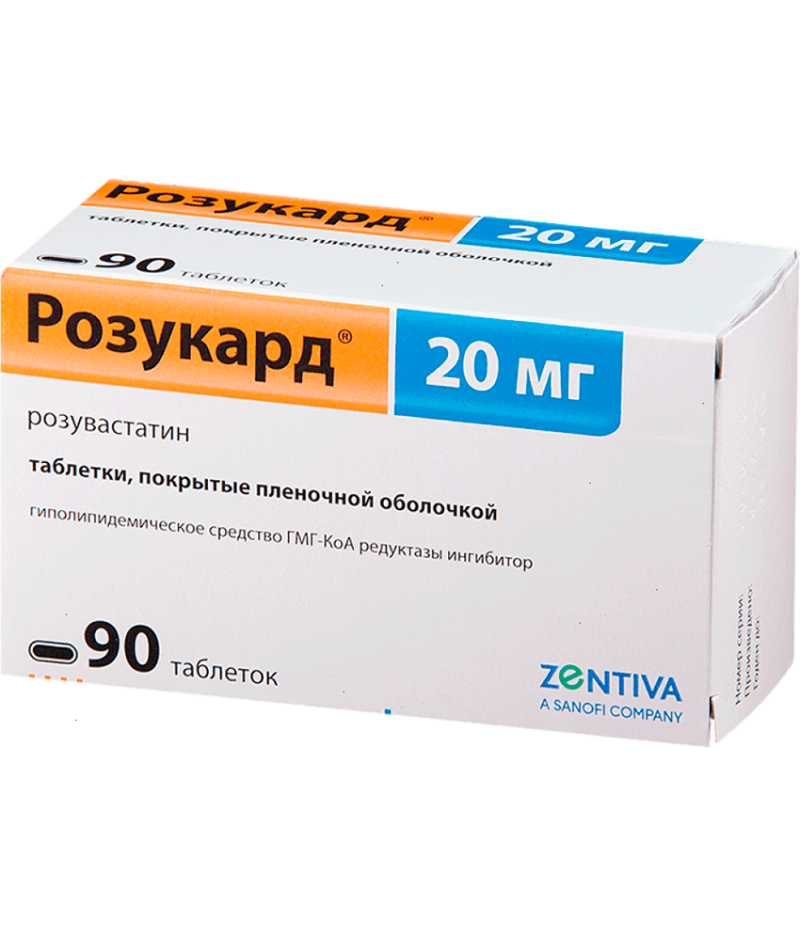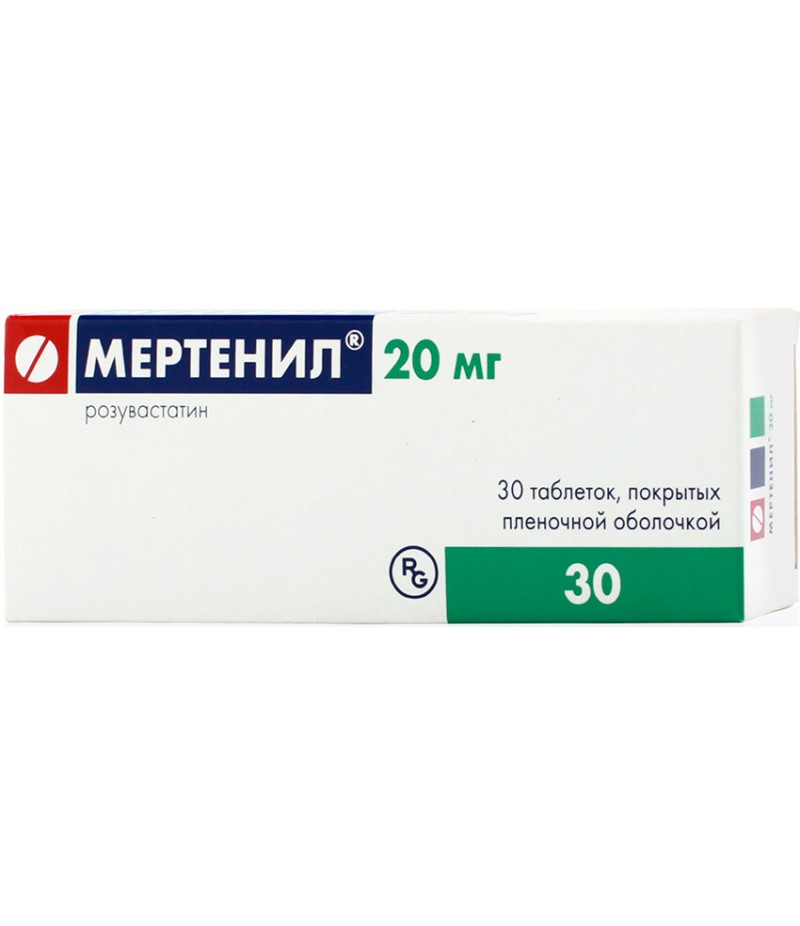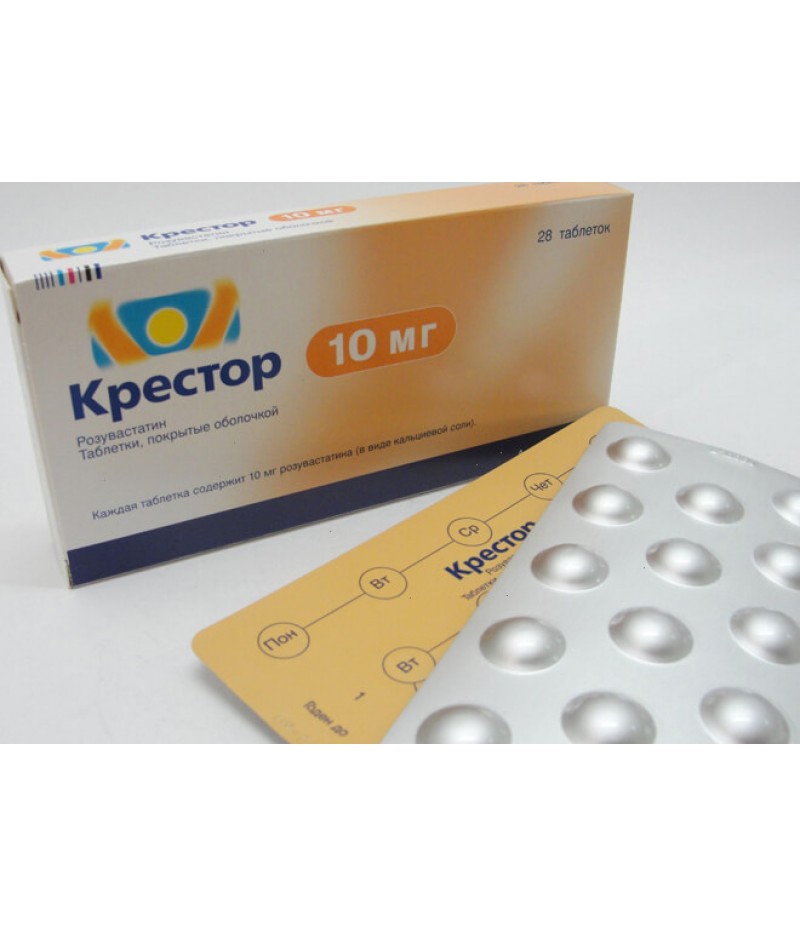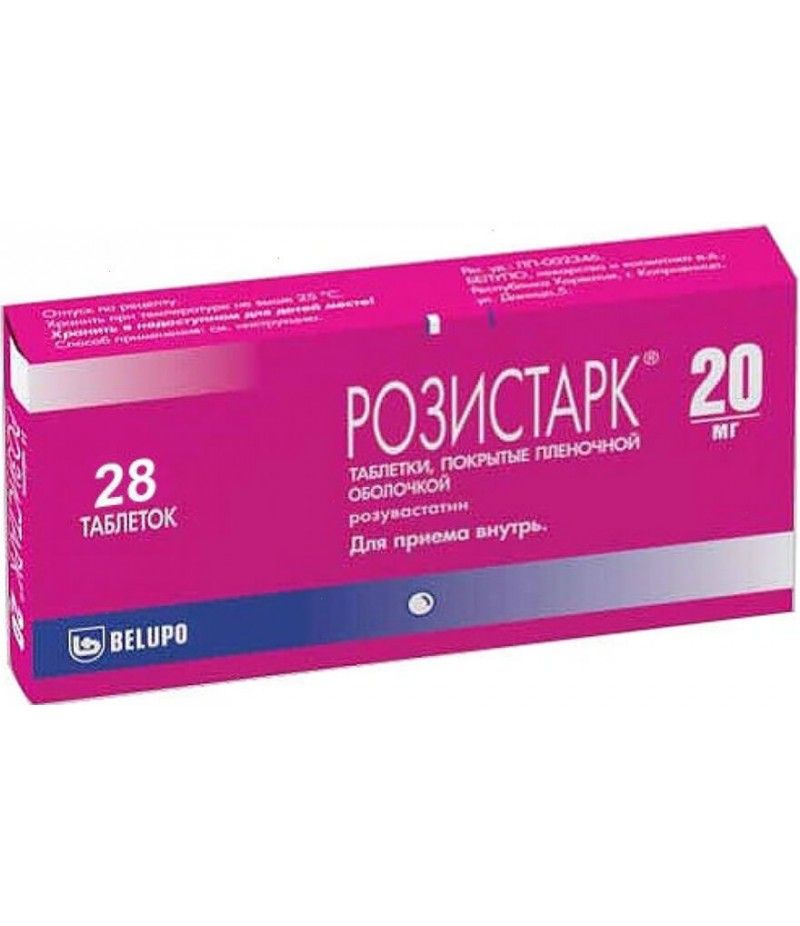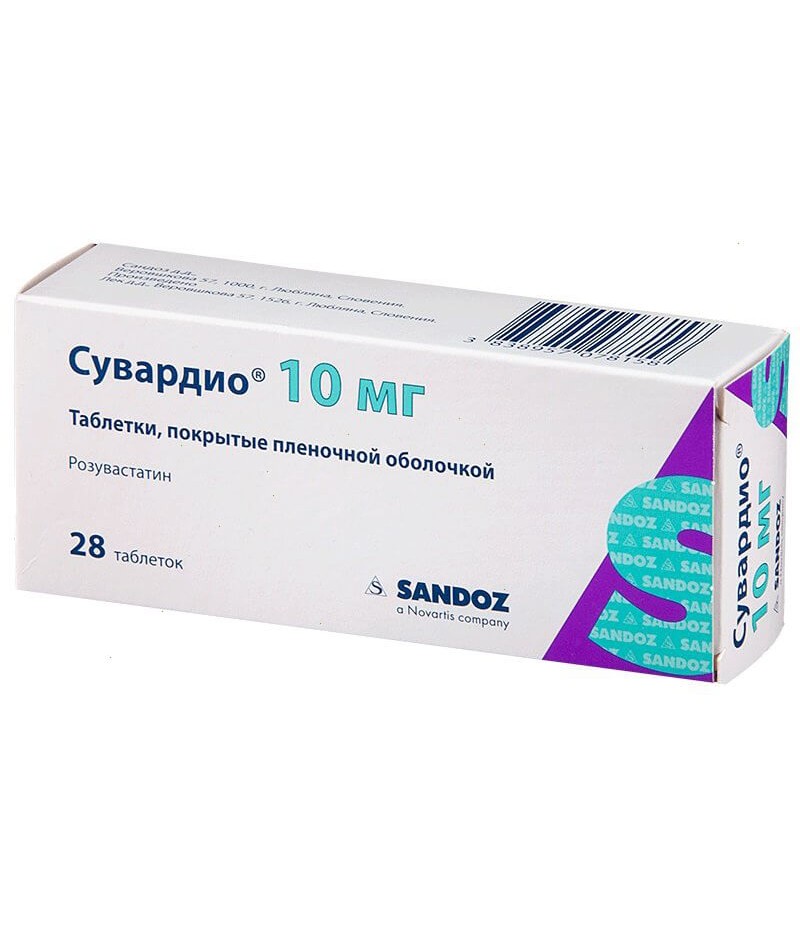Roxera tabs 15mg #30
- $39.90
- 3 or more $38.55
- Availability:In Stock
Roxera instructionYou can buy Roxera hereTo buy other dosage please contact usCompositionThe composition of one pill of the Roxera includes 5, 10, 15, 20, 30 or 40 mg of rosuvastatin in the form of calcium rosuvastatin and auxilia..
Tags: tabs
Roxera instruction
You can buy Roxera here
To buy other dosage please contact us
Composition
The composition of one pill of the Roxera includes 5, 10, 15, 20, 30 or 40 mg of rosuvastatin in the form of calcium rosuvastatin and auxiliary components:
microcrystalline cellulose;
lactose anhydrous;
crospovidone;
silicon dioxide colloidal anhydrous;
magnesium stearate.
The shell, which is coated with tablets, contains in its composition:
butyl methacrylate, dimethylaminoethyl methacrylate and methylcrylate copolymer in a ratio of 1: 2: 1;
macrogol 6000;
titanium dioxide;
lactose monohydrate.
Form of issue
The roxera is available in the form of tablets coated with a white film shell, which differ in appearance depending on the concentration of the active substance in them:
Tablets with a content of rosuvastatin in a dose equal to 5, 10 or 15 mg, have a round shape, biconvex, with a facet. On one side, the labeling corresponding to the dose of the active substance is made: "5", "10" and "15", respectively.
Tablets with rosuvastatin in a dose equal to 20 mg, round, biconvex, with a facet.
Tablets with a content of rosuvastatin in a dose equal to 30 mg, biconvex, have a capsular form and risks from both sides.
Tablets with a content of rosuvastatin in a dose equal to 40 mg, biconvex, have a capsular form.
On the side of the tablet, two layers are clearly visible, the inner layer is white.
pharmachologic effect
The pharmacological action of the drug Roxera is aimed at:
Suppression of the activity of the microsomal enzyme hydroxymethylglutaryl-CoA reductase, which acts as a catalyst for the early early stage of cholesterol synthesis.
Normalization of the lipid profile (hypolipidemic effect) by lowering the concentration of total cholesterol, triglycerides, low density lipoprotein in the blood, as well as increasing the concentration of high-density lipoproteins.
The drug belongs to the pharmacological group "Statins".
Pharmacodynamics and pharmacokinetics
Getting into the body, rosuvastatin provokes the following effects:
Helps reduce elevated concentrations of low-density lipoprotein cholesterol;
Helps reduce elevated concentrations of total cholesterol;
Helps reduce elevated concentrations of triglycerides;
Promotes increased concentrations of high-density lipoprotein cholesterol;
Helps reduce the concentration of apolipoprotein low-density lipoproteins (apoliprotein B);
Helps reduce the concentration of low-density lipoprotein cholesterol;
Helps reduce cholesterol levels of very low density lipoproteins;
Helps reduce the concentration of triglycerides of very low density lipoproteins;
Helps increase the concentration of blood apoliprotein A1;
Reduces the ratio of the ratio of low-density lipoprotein cholesterol to high-density lipoprotein cholesterol;
Reduces the ratio of total cholesterol to high-density lipoprotein cholesterol;
Reduces the ratio of low-density lipoprotein cholesterol to high-density lipoprotein cholesterol;
Reduces the ratio of apolipoprotein low-density lipoprotein (apoliprotein B) to apolipoprotein A1.
The pronounced clinical effect of the use of Roxera develops a week after the start of the course of treatment with the drug. Approximately 90% of the maximum effect of therapy is observed after two weeks.
To achieve maximum effect, usually takes four weeks, after which it is maintained throughout the subsequent treatment period.
The maximum plasma concentration of rosuvastatin is noted five hours after taking the pill, the absolute bioavailability is 20%.
Rosuvastatin extensively biotransformed in the liver, which is the primary center that synthesizes cholesterol and metabolizes low-density lipoprotein cholesterol.
The distribution of matter is approximately 134 liters. About 90% of rosuvastatin binds to plasma proteins (mainly albumin).
Rosuvastatin is metabolized to a limited extent (about 10%). In vitro studies of human metabolism using human hepatocytes have shown that it is only susceptible to minimal metabolism based on the cytochrome P450 enzyme system. And this metabolism can not be considered clinically important.
The main isoenzyme involved in the metabolism of rosuvastatin is CYP 2C9. To a somewhat lesser extent, the isozymes 2С19, 3А4 and 2D6 take part in the process.
In the process of metabolism, two main metabolites were isolated:
N-desmethyl;
lactone.
N-desmethyl is approximately half as active as rosuvastatin. As for lactone, it is considered a clinically inactive form.
Rosuvastatin has more than 90% inhibitory activity against hydroxymethylglutaryl-CoA reductase (HMG-CoA reductase), which circulates in the human body in the general bloodstream.
Most of the rosuvastatin (approximately 90%) ingested is excreted unchanged with the intestinal contents. In this case, both the absorbed and the nonabsorbed active substance are excreted.
The remainder of rosuvastatin is excreted by the kidneys together with the urine (approximately 5% - unchanged).
The half-life of the substance is about 20 hours and does not depend on the increase in the dose of the drug. The average clearance from the blood plasma is about 50 liters per hour. The indicator of variability relative to the average value (coefficient of variation) is 21.7%.
As with other agents that suppress the activity of hydroxymethylglutaryl-CoA reductase, rosuvastatin's liver uptake contributes to the involvement of the membrane transporter OATP-C, which plays an important role in the process of removing the substance from the liver.
Rosuvastatin is characterized by a dose-dependent systemic exposure, which increases in proportion to the increase in the dose of the substance.
Multiple daily use of the drug does not provoke any changes in the pharmacokinetic characteristics of its active substance.
The patient's age and sex do not influence the pharmacokinetics of the drug. However, studies have shown that in patients of the Mongoloid race, the AUC and maximum plasma concentrations of rosuvastatin are approximately twice as high as those of patients belonging to the Europoid race.
Indians have similar indicators that exceed those for Caucasians by approximately 1.3 times. There are no clinically significant differences in indices for representatives of the Negroid race and Caucasoids.
In patients with renal insufficiency in mild or moderate form, the values of the highest concentration of rosuvastatin and N-desmethyl in the plasma remain practically unchanged.
In severe forms of renal insufficiency, the value of the highest plasma concentration of rosuvastatin increases approximately threefold, and the index of the highest plasma concentration of N-desmethyl is approximately nine times higher than that observed in healthy volunteers.
The plasma concentrations of rosuvastatin in patients who were on hemodialysis exceeded those in healthy volunteers by approximately half.
With liver failure due to chronic alcoholic liver diseases, the plasma concentrations of rosuvastatin are moderately elevated.
In patients whose disease is classified as Class A on the Child-Pugh scale, the highest plasma rosuvastatin concentration and AUC are increased by 60% and 5%, respectively, compared to patients whose liver is healthy.
If the liver disease belongs to the B category on the Child-Pugh scale, the indices are respectively increased by 100 and 21%. For patients whose disease belongs to category C, there is no data, which is due to the lack of experience with rosuvastatin.
Indications for use
The Roxera shows:
For the treatment of patients suffering from primary-type hypercholesterolemia (including familial hypercholesterolemia II-A by Fredrickson) or mixed type dyslipidemia (type II-b). It is advisable to prescribe the drug when the expected therapeutic effect can not be achieved by the appointment of non-drug therapies: diet, weight correction, physical exercises, etc.
For the treatment of patients diagnosed with familial homozygous hypercholesterolemia. Roxera is prescribed as an adjunct to therapy, whose goal is to reduce lipid levels, as a supplement to the diet, and also in those cases when the previously prescribed treatment does not give positive results.
For the treatment of patients who are diagnosed with atherosclerosis. The drug is used as a supplement to the prescribed diet to slow the progression of the disease, as well as to reduce the total cholesterol and low density lipoprotein cholesterol to the required level.
As a preventive agent, preventing the development of complications of heart and vascular diseases in patients with a predisposition to the development of atherosclerotic vascular lesions.
Contraindications
Contraindications to the appointment of tablets Roxera with rosuvastatin in doses of 5, 10 and 15 mg are:
hypersensitivity to one or more of the components of the drug;
active forms of liver pathologies (including diseases of an unclear origin), as well as conditions characterized by a steady increase in the level of hepatic transaminases, and conditions in which any of the hepatic transaminases rises no less than threefold;
kidney pathology, in which creatinine clearance does not exceed 30 ml / min;
chronic progressive hereditary neuromuscular diseases that are characterized by primary muscle damage (myopathy);
simultaneous use of an antidepressant Cyclosporine;
diagnosed in the patient an increased risk of myotoxic complications;
lactose intolerance;
lactase insufficiency;
glucose-galactose malabsorption;
pregnancy (also the drug is not prescribed to women of reproductive age, unless they use contraceptives);
lactation;
age to 18 years.
Tablets with a dosage of rosuvastatin 30 and 40 mg are contraindicated:
patients with hypersensitivity to one or more components of the drug;
patients with active forms of liver pathologies (including diseases of an unknown origin), as well as conditions characterized by a steady increase in the level of hepatic transaminases, and conditions in which any of the hepatic transaminases rises no less than three times;
kidney pathology in which creatinine clearance does not exceed 60 ml / min;
chronic progressive hereditary neuromuscular diseases that are characterized by primary muscle damage (myopathy);
hypothyroidism;
simultaneous use of an antidepressant Cyclosporine;
a patient diagnosed with an increased risk of developing myotoxic complications (when a history of the patient has a muscle toxicity mark that was provoked by another drug-inhibitor of hydroxymethylglutaryl-CoA reductase or a drug that is a fibroic acid derivative);
alcohol addiction;
severe forms of liver failure;
belonging of the patient to the Mongoloid race;
simultaneous reception of fibrates;
lactose intolerance;
lactase insufficiency;
glucose-galactose malabsorption;
pregnancy (also the drug is not prescribed to women of reproductive age, unless they use contraceptives);
lactation;
age is 18 and over 70 years.
Side effects
On the background of treatment with Roxera, the following side effects can be noted:
disorders of the immune system, including reactions due to hypersensitivity to rosuvastatin or other ingredients of the drug, including the development of angioedema;
disorders of the digestive system, expressed in the form of frequent constipation, pain in the epigastric region, attacks of nausea; in rare cases, pancreatitis may develop;
disorders arising from the skin and subcutaneous tissues and expressed in the form of rashes on the skin, skin itching, urticaria;
disorders of the function of skeletal muscles, which manifest themselves in the form of myalgia (often) and sometimes myopathy and rhabdomyolysis;
violations of a general nature, the most frequent of which is asthenia;
disorders of kidney and urinary tract, which are often accompanied by an increase in the concentration of protein in the urine.
A Roxera may influence the change in laboratory parameters. So, after taking the drug, the activity of creatine kinase, glucose concentration, bilirubin, hepatic enzyme gamma-glutamyltranspeptidase, alkaline phosphatase, and plasma hormone levels in the thyroid gland can increase.
The frequency and severity of side effects are dose-dependent values.
Roxera tablets: instructions for use, method of administration and dosing regimen
Before the appointment of the drug, the patient is recommended to switch to a standard diet, the purpose of which is to lower the level of cholesterol. To adhere to this diet is necessary and throughout the course of treatment.
The dose is selected individually by the attending physician depending on the purpose of therapy and its effectiveness. Take the drug is allowed at any time of the day, without being tied to the time of eating.
The tablet is swallowed whole, not crushing, not chewing and squeezed with enough water.
Patients with hypercholesterolemia should start taking the drug with doses equal to 5 or 10 mg of rosuvastatin. Tablets are taken orally, one per day. Moreover, this condition persists both for patients who have not been treated with statins, and for patients who have already been treated with drugs suppressing the activity of hydroxymethylglutaryl-CoA reductase.
Determining the initial dose of Roxera, the doctor pays attention to the cholesterol concentration indicators, and also assesses the risks of developing cardiovascular complications and side effects.
In cases where this is necessary, the dose may be adjusted to the next level, however, such an adjustment shall be made no earlier than 4 weeks after the first appointment.
Given that the adverse reactions are dose-dependent, and when taking 40 mg of rosuvastatin occur more frequently than when taking it in smaller amounts, increasing the daily dose to 30 or 40 mg should be done with particular care for:
patients with severe forms of hypercholesterolemia;
patients who are at high risk of complications from cardiac and vascular function (in particular, if the patient is diagnosed with familial hypercholesterolemia).
If taking smaller doses of rosuvastatin in these patients does not give the expected result, after the appointment of the Roxera at a dosage of 30 or 40 mg per day, the patients must always be under the control of the doctor treating them.
Also, regular follow-up at the doctor is indicated in those cases when treatment starts immediately with a dose of 30 or 40 mg.
In accordance with the instructions for use, 20 mg of Roxera is indicated as the initial dose for the prevention of heart and vascular diseases in patients who are at increased risk of developing such pathologies.
People with moderate impairment of kidney function are not required to adjust the dose, however, this drug is prescribed with caution.
For violations of moderate renal function, when creatinine clearance is within 60 ml / min, treatment starts with a dose of 5 mg. High doses of the drug (30 and 40 mg) should be contraindicated.
Patients with severe forms of renal dysfunction are prohibited from prescribing the drug at any dosage.
When Roxera is prescribed to patients with liver pathologies, whose Child-Pugh score does not exceed 7, there is no increase in system exposure of rosuvastatin.
If the indicators of violations of liver function are equal to 8 or 9 on the Child-Pugh scale, the system exposure is increased. Therefore, before prescribing a drug, such patients need additional research on kidney function.
The experience of treating patients whose indicators exceed 9 on the Child-Pugh scale is not available.
Overdose
Clinical manifestations that may occur if the dose of the drug recommended by the instruction is exceeded are not described. After a single dose of Roxera in a dose several times greater than the established daily, there were no clinically significant changes in the pharmacokinetics of rosuvastatin.
In case of an overdose and the appearance of symptoms of intoxication, symptomatic treatment is shown and, if necessary, the appointment of a set of supportive measures.
It is also recommended to monitor the level of activity of the creatine kinase and conduct a test to assess the functionality of the liver.
The expediency of prescribing hemodialysis is considered unlikely.
Interaction
With the appointment of Roxera in combination with Cyclosporin, the values of AUC of rosuvastatin significantly increase (approximately sevenfold), while the plasma concentration of cyclosporine remains unchanged.
With simultaneous administration with drugs, which are vitamin K antagonists or drugs that suppress the activity of hydroxymethylglutaryl-CoA reductase in the early course of treatment, as well as with increasing daily dose by its titration may be marked increase in the INR (international normalized ratio).
As a rule, against the background of a reduction in the dose by titration or complete discontinuation of the drug, this indicator decreases.
Simultaneous reception with lipid-lowering drug Ezetimibe does not provoke changes in the AUC and maximum plasma concentrations of both drugs, however, the possibility of pharmacodynamic interaction is not ruled out.
In combination with gemfibrozil and other drugs that help reduce lipid levels, it provokes a two-fold increase in the AUC and maximum plasma concentrations of rosuvastatin.
Data from special studies have shown that the appointment with Fenofibrate is potentially not welcome to changes in pharmacokinetic parameters, but the likelihood of pharmacodynamic interaction of the drugs is not ruled out.
And drugs such as fenofibrate, gemfibrozil and nicotinic acid preparations, while their purpose with inhibitors of hydroxymethylglutaryl-CoA reductase increases the risk of myopathy (which is likely due to their ability to induce a similar effect when administered as monotherapy).
With the simultaneous use of Roxera with fibrates, rosuvastatin in doses equal to 30 and 40 mg is not prescribed. The initial daily dose of rosuvastatin for patients taking fibrates is 5 mg.
Simultaneous use of the drug with inhibitors of serine proteases provokes a change in the exposure of rosuvastatin. For this reason, Roxera is not assigned to HIV-infected patients who are being treated with serine protease inhibitor drugs.
With simultaneous administration with antacids, the plasma concentration of rosuvastatin decreases approximately two-fold. To reduce the severity of this effect, antacids should be taken two hours after taking the pill of the Roxera.
Against the background of simultaneous appointment of rosuvastatin with Erythromycin, the AUC value of rosuvastatin is reduced by 20%, and its plasma concentration is about one third. This may be due to increased mobility of the intestinal tract, which provokes the reception of Erythromycin.
When assigning Roxera in combination with hormonal contraceptives for oral administration AUC ethinylestradiol index is increased by 26%, while the figure for norgestrel - 34%.
Such an increase in AUC levels should be considered when choosing the optimal dose of a contraceptive for oral administration.
Pharmacokinetic data regarding simultaneous admission with drugs for hormone replacement therapy are not available, however, the probability of interaction and AUC increase is not excluded.
Studies of the combination of rosuvastatin with a pacemaker Digoxin showed no clinically significant interaction.
Rosuvastatin does not exert either an inhibitory or stimulating effect on the isoenzymes of the cytochrome P450 system. In addition, the metabolism of rosuvastatin under their influence is minimal and not clinically significant.
There has been no significant interaction between rosuvastatin and antifungal agents with fluconazole and ketoconazole, which inhibit the activity of cytochrome isoenzymes.
The combination with the antifungal drug Intraconazole, which inhibits the activity of the CYP 3A4 isoenzyme, provokes an increase in the AUC of rosuvastatin by 28%. However, this increase is not considered clinically important.
Storage conditions
Special requirements for the storage of the drug are absent.
Shelf life - 2 years after the date of manufacture.
Roxera Reviews
Roxera pills - reviews left on the forums by the patients taking the drug confirm this fact - is an effective tool for lowering cholesterol.
To the main advantages of the drug, many of them include a pronounced result, which is noted in a shorter period than when taking similar Roxera by its pharmacological action means.
Moreover, the improvement of the clinical picture often occurs against the background of an order of magnitude lower in comparison with analogues (for example, Sigmal) dose.

